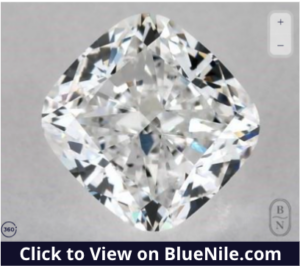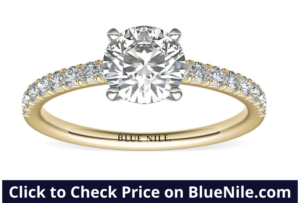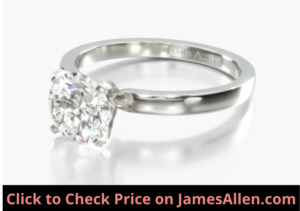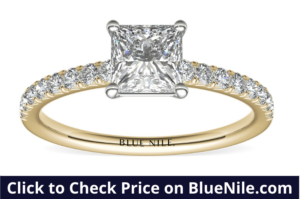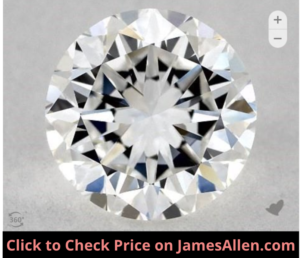- By Jacob Clarke
- jacob.clarke@teachjewelry.com
- Last Updated: October 2, 2023
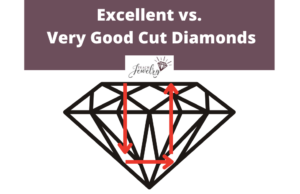
A diamond’s cut is the most important factor in its appearance and performance.
While most buyers spend an equal amount of time examining carat weight and color and clarity grades, a low-quality cut can negate even high marks in those other areas.
The Gemological Institute of America (GIA) and most other organizations that assess diamonds grade a diamond’s cut on a scale from poor to excellent, with very good, good, and fair in between.

The main difference between an excellent and very good cut diamond is that an excellent cut diamond exhibits strong brilliance and fire because its proportions and finish maximize the light return. Very good cuts don’t reflect as much light, so they aren’t as popular for engagement rings.
To help you decide which cut is right for you, we’ll compare excellent versus very good cut diamonds, including an overview of each and their three distinctions.
What is an Excellent Cut?
There are many criteria that determine a diamond’s cut grade. An excellent cut scores well across almost all of them.
Specifically, a gemologist examines the following traits:
- Proportions: the size and ratios of a diamond’s table, depth, and width
- Polish: the quality and shine of its surface
- Symmetry: the arrangement and precision of facets
We’ll start with excellent proportions for a round-cut diamond and the fact there’s no single ratio or percentage for it to earn the high grade.
Instead, it’s a range that should be viewed as a guideline.
Table percentage measures the width of its table compared to the total width of the diamond.
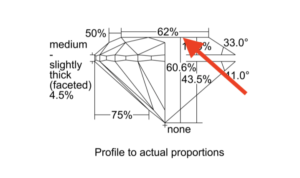
In a perfectly cut diamond, the table is large enough to maximize how much light enters. A poorly cut table results in a dullness.
Depth percentage calculates its height compared to width.
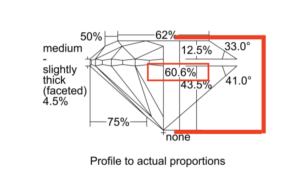
A deeper diamond has a higher depth percentage.
An optimal table and depth percentage are crucial for an excellent cut grade.
For round-cut diamonds, search for a table percentage between 54 and 58 percent. The ideal depth percentage is between 59 and 62.5 percent.
For example, this round-cut diamond falls within that range. Its table percentage is 56 percent, and its depth percentage is 62.2 percent.
While the GIA and others don’t provide cut grades for fancy shapes, the chart below shows ideal table and depth percentages.
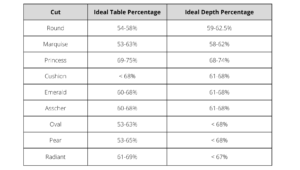
Like the overall cut grade, symmetry and polish are graded from poor to excellent.
A diamond earns an excellent symmetry grade if there are only a few deviations discovered with 10x magnification. Examples include:
- Off-center tables or culets
- The diamond is “out of round,” (some areas appear squared off)
- Crown or pavilion misalignment
- Misshapen facets
To determine polish, gemologists scan for the smoothness and condition of its surface. If there are any abrasions, burns, pits, or a rough girdle, it may not receive an excellent grade.
So in most cases, excellent cut diamonds receive the highest grade on both.
As an example, here’s a diamond with excellent polish and symmetry.
Along with its ideal depth percentage and thin to slightly thick girdle, it earned an excellent cut grade.
What is a Very Good Cut?
A very good cut grade is positioned below excellent but above good, fair, and poor.
Thus, its overall cut quality is inferior to excellent cut diamonds but still demonstrates strong performance compared to most on the market.
It’s why many who are shopping for an engagement ring decide to save on price by choosing a very good cut, like the diamond below.
But as you’ll learn, there are several reasons I don’t recommend it.
The grade doesn’t indicate the exact criteria where the diamond matches or falls short of the standards for an excellent cut.
For example, it may or may not have the ideal table and depth percentages, or it could have very good or excellent symmetry and polish grades.
Instead, the very good cut grade signifies that when these factors are combined, it doesn’t reach the quality set by an excellent cut.
For example, check out this round-cut with a very good cut grade.
By viewing its GIA report, there are a few areas that stand out:
- Its table percentage is 59 percent, which is higher than the ideal range
- The diamond’s depth percentage is 63.9 percent and higher than ideal
- Its facet is slightly thick to thick, but excellent cuts often receive thin to slightly thick
- A very good symmetry grade indicates minor issues with facets
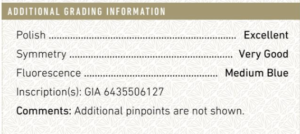
None of these metrics are far from what would traditionally earn an excellent cut, but the combination likely kept it at very good.
So although aspects of the diamond like its depth and table percentage, length to width ratio, and girdle thickness are objective measurements, how these factors culminate into a cut grade like very good or excellent is subjective.
This underscores the importance of choosing a diamond grading by a reliable lab like the GIA.
How are Excellent and Very Good Cut Diamonds Different?
1. Excellent Cuts Display More Brilliance, Fire, and Scintillation
Brilliance refers to the white light reflecting from a diamond. When light hits its facets, the diamond collects light and returns it to the viewer. It’s one of the most coveted traits, especially for engagement rings.
Fire is the rainbow of light that radiates from a diamond. The white light is dispersed when it hits the diamond’s facets due to refraction.
Scintillation is a combination of fire and brilliance. It’s the interaction between the white and colored light that displays when it’s twirled.
An excellent cut diamond generally demonstrates more brilliance, fire, and scintillation compared to very good cuts because its facets and proportions allow it to return the most light.
Check out this diamond ring with an excellent cut.
When you rotate the image 360 degrees on the vendor’s site, its sparkle is obvious at every angle.
Some cuts, such as princess, radiant, and cushions, are known for their fire.
Combine it with a quality cut, and it’ll display strong flashes of colored light.
Very good cuts still display brilliance, fire, and scintillation, but it’s sometimes noticeably less compared to excellent cuts.
Whether it’s a result of proportions that aren’t ideal, a rough surface, or misshapen facets, a smaller amount of light is reflected back to the viewer.
Because of the way a diamond’s sparkle impacts its appearance and performance in a piece of jewelry, this isn’t the area to compromise.
In regard to light return, it’s also worth noting that brilliant cuts are far superior to step-cuts like Asscher and emerald diamonds. Even a strong cut with those fancy shapes can’t compete with round, princess, and marquise.
2. Very Good Cuts are Less Expensive
The price of a diamond generally increases as you move up the GIA scales for cut, color, and clarity. The same is true of its carat weight.
All else being equal, buyers pay a premium for improved grades across the four Cs.
To provide specifics about how very good cuts are less expensive than excellent cuts, I assessed prices for 310 round-cut diamonds from James Allen.
They had the following grades:
- Carat weight: 0.90
- Clarity: VS1
- Color: G
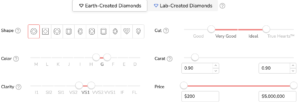
For ones with a very good cut, the average price was $5,334, with a range of $5,040-$7,550.
The excellent cuts averaged $6,160, and the range was $5,850-$7,410.
That’s a 15 percent higher price for excellent versus very good cut diamonds.
You might be tempted to put that 15 percent savings into an improved color or clarity grade. With that savings, you could also choose a different setting or a heavier diamond.
But when it comes to a diamond’s cut grade, the premium for excellent over very good is worth it.
If you want to stay within a certain price range, select a lower grade in another area and find a diamond that still exhibits exceptional light performance.
3. Excellent Cuts are Ideal for Engagement Rings
Excellent cuts are an ideal choice for engagement rings.
You don’t want the center diamond appearing dull. It commands the most attention and should be clean and colorless to the naked eye.
By opting for an excellent cut over a very good cut, you maximize performance in the most important area, which is the sparkle when you show it off.
Even if you chose a high clarity and color grade on a large diamond, any cut less than excellent can diminish those other qualities.
There’s no sense in paying a high price for a lack of inclusions or color if the diamond is still lackluster.
Let’s examine this diamond’s GIA report as an example.
It has VVS1 clarity, an F color grade, and excellent symmetry and polish.
But its proportions are far outside the ideal range. With a table and depth percentage of 66 and 64.9, respectively, it isn’t cut to maximize light return.
The performance isn’t what you’d expect from an engagement ring diamond.
As a contrast, check out this excellent cut.
Although its measurements aren’t perfect in every area, they’re enough to earn it the highest cut grade.
With an excellent cut diamond at the center, you could also combine it with a pave setting, which features small gems lining the shank.
It allows the whole piece to sparkle.
While some choose these settings to compensate for a very good cut as the main gem, I recommend prioritizing the quality of its cut over a particular engagement ring setting.
It’s worth the premium.
Is an Excellent or Very Good Cut Right for You?
If you’re comparing excellent versus very good cut diamonds, you should understand how its cut impacts all aspects of its appearance and light performance.
Beyond traits like proportions, girdle thickness, and the shape of its facets, cut is central to how a diamond will complement a piece of jewelry.
We recommend choosing a diamond with an excellent cut that falls within the ideal ranges.
Issues with even one of those qualities can affect how it’ll appear, so diligently review the diamond’s grading report to learn about these traits.
And don’t neglect viewing the diamond in person or through high-resolution images online.
They’ll give you confidence about what to expect, so you create the perfect diamond ring for you.

Jacob Clarke
Jacob Clarke is the founder of TeachJewelry.com.
He earned an Applied Jewelry Professional Diploma from the Gemological Institute of America (GIA) and now brings you essential information about diamonds, settings, and more.
Jacob has consulted with leading jewelry brands, and his work has been cited in Clean Origin, Diamond Nexus and industry publications.
He's also a member of the International Gem Society.
He enjoys discussing jewelry with readers, so contact him with any questions at jacob.clarke@teachjewelry.com.

